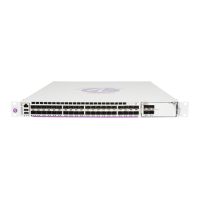Automatic Discovery Protocol
138 7705 SAR-M Chassis Installation Guide
When run on the system, ADP goes through four basic stages:
• Self-discovery
• Network discovery
• Configuration discovery
• Test and commit
If ADP encounters errors during one of the discovery stages, it enters a halted state until the
errors are cleared. ADP can detect some cleared errors and will continue processing. For other
cleared errors, you must give ADP a command to retry through the CLI or with the ACO/LT
button. This causes ADP to clear the rejected DHCP server list for all ports and retry any
processing that failed. If still in a halted state after 15 min, ADP times out and reboots the
system. During the reboot, ADP will attempt to run again.
If ADP is halted, the major and minor alarm LEDs on the 7705 SAR-M chassis indicate the
ADP stage. Table 27 describes the LED combinations and corresponding ADP stage.
ADP runs in the background to allow continued CLI access for status queries and
troubleshooting. Periodic progress updates are sent to the console and can be viewed through
a connected PC. Additionally, dump commands are available to display information and
detailed logs about ADP during and after running on the system. The logs are not retained
over a chassis reboot.
After ADP successfully completes, or if it is manually terminated, the system sends a
command to the BOF to remove the ADP keyword. Any temporary configuration done by the
ADP is removed; however, network configuration and remote access remain enabled to allow
the router to be manually provisioned remotely. ADP does not run again on future system
reboots unless it is re-enabled via the CLI.
Table 27: ADP Stage LED Indicators
ADP Stage Major Alarm LED Minor Alarm LED
Self-discovery Off Off
Network discovery Off On
Configuration discovery On Off
Test and commit On On

